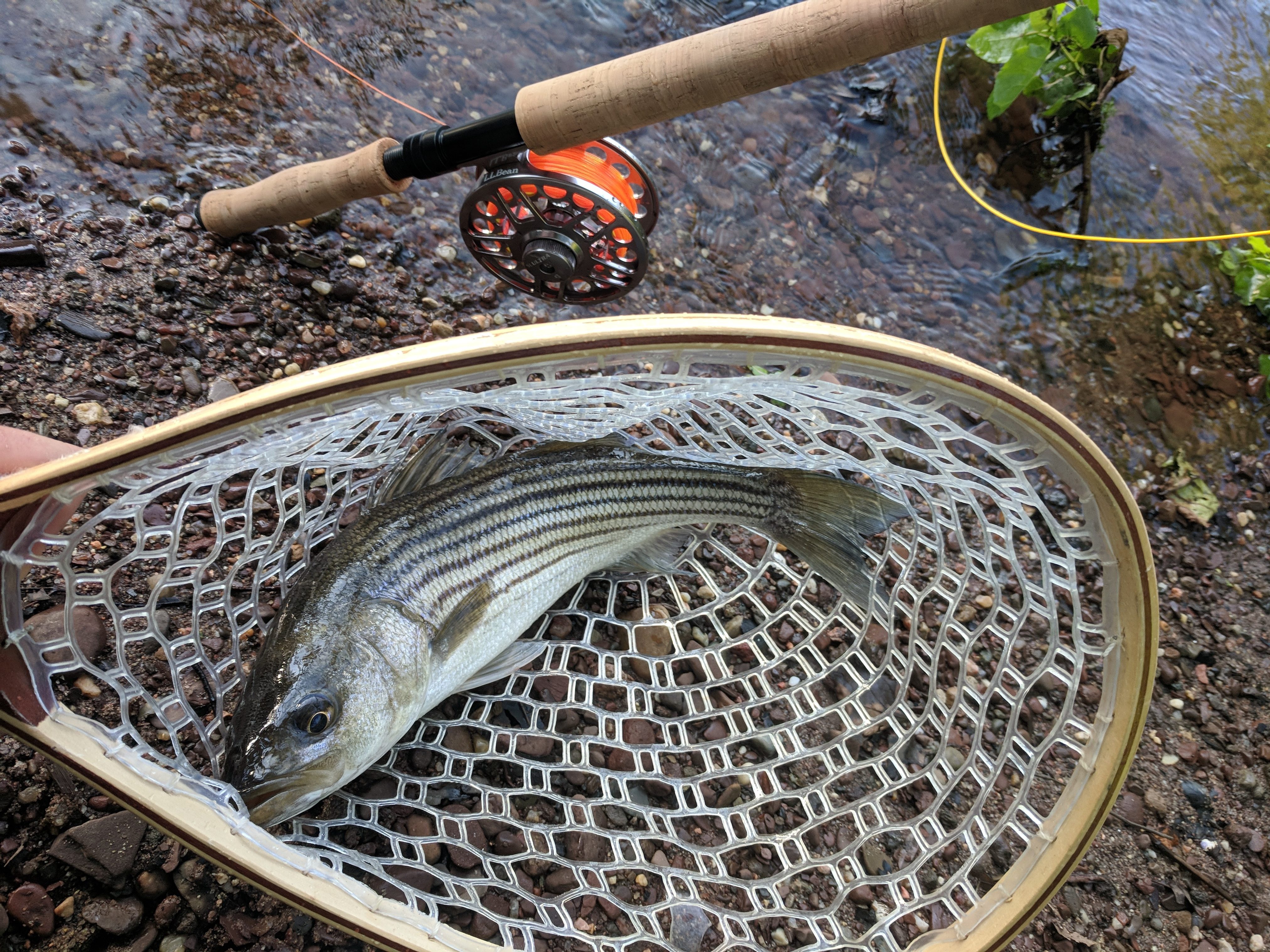I’m a firm believer that catching a native fish on a swung streamer is one of the most satisfying feelings in our sport. For most Americans, Skamania steel and sea-run trout are too far of a drive and thus not an option for casual weekend fishing. In places like southern New England, our chance to swing into thick runs of fish really only comes between late May and mid-July. In this short but glorious window, mediated by the annual runs of hickory shad (a.k.a. “Yankee tarpon” or “baby tarpon”), we get a shot our favorite anadromous species: the striped bass (Morone saxatilis).
Generally speaking, stripers need three things to reproduce and survive:
- Big, clean, cool rivers with a good flow
- Big, stable, predictable runs of forage species
- Big, safe estuaries that protect ‘schoolie’ juveniles
These criteria are met by the many broad, tidal rivers of the eastern seaboard of the US and Canada, each of which has the potential to hold impressive numbers of fish during the late spring through early summer run. Indeed, the size of this run has fluctuated over the past 20 years but its timing and consistency are the Northeast’s counterpunch to the steelhead and salmon runs of the Pacific Northwest. This is especially true for the fish who begin their journey in the Chesapeake and Hudson Rivers and push north into Canada. Many of the largest fish are caught between Atlantic City and Cape Ann, and this stretch of water has yielded the last two world record all-tackle stripers (of note, my home water still holds the standing world record — 81.88 lbs cow). The concentration of “cows” in the northeast of the US is impressive considering that stripers can be found all over the Atlantic Ocean, spanning the Gulf of Mexico and Prince Edward Island.

The most notable spawning waters for striped bass are centered around the Chesapeake Bay, the Delaware Bay, Hudson River and western Long Island Sound, south-facing bays in southern New England (e.g., Connecticut River), and the Massachusetts Bay, Cape Cod, and Cape Ann Bays: during the leading and trailing waves of the striper migration, these watersheds will run thick with juvenile striped bass (“schoolies”).
Like steelhead, these fish are on the move. So how do I catch these bad boys on the fly? By swinging! Here are my favorite rigs, patterns, and approaches to landing migrating striped bass on the fly.
Quick tip: before setting out, check your local tide chart and fish an hour on either side of the high and low tides. If fishing in rivers and canals, check USGS for streamflows and try to fish high (but falling) water.
Rods, Lines, and Reels
There are two great ways to target schoolies on the fly. The first option is using a stout, 9 foot 8 weight single-handed rod. Depending on the kind of water you’re fishing, you could opt for a full-sinking line (like during high flows) or an intermediate line in slower, lower water. The second option is to use a traditional Spey or switch rod (side note: if you’re into DIY, you could even make your own two-handed rod as outlined here). For Spey rods, anything above 12’6″ feet and 7/8 wt will provide more than enough backbone to land fish above the 20″ – 24″ range. Given that I do the majority of my fishing in estuarine waters, I have usually kept three rods rigged and in my car rack at all times so that I can easily adapt my presentation to match forage species and tidal changes. These three rods are:
- A 9′ 8wt rod, equipped with an Orvis Hydros intermediate line,
- My DIY 9′ 5wt switch (8 wt single handed) rod equipped with a 300-grain OPST Commando Head,
- A 13′ 8wt Spey rod, equipped with 30′ of Rio level T-14 line.
Each of these has an appropriately sized large-arbor reel with 150 – 200 yards of 30 lb dacron backing. I will occasionally use a 360-grain Scientific Anglers Third Coast Skagit head on my Spey rod, secured with a loop-to-loop knot to 40 lb test mono running line. On this Spey rod, the T-14 is a straight (level) line and must be loaded using the current: do not try to overhead cast this with a large streamer! In a high wind, you can overload your rod and snap it.
Patterns
For streamers, traditional, sparsely-tied bucktails such as Lefty’s Deceivers or Clouser Minnows will always produce for stripers. Big, aggressive streamers like a 12″ Beast Fleye might be overkill for smaller fish, but I always like to keep some handy in the even that I see larger fish. This season, I’ve had my most luck on articulated deceivers tied with barred hackle and a peacock wing.

After watching a bait caster land a 30″ striper on squid, and after having a bluefish regurgitate a small sand eel while in my net, I tied these bad boys up and had a decent amount of success:


Other things to consider bringing:
- Headlamp: the last thing you want is to be stuck on a sandbar at low light
- Stripping basket: trust me, these things are a game changer.
- Safety “Boot knife”: having a knife such as a Morakniv Companion can be the difference between getting dragged into a rip, and freeing yourself from a tangled line or swamped waders.
- Bite Wire: if there are stripers, there might be blues. Be sure to use a wire leader if you suspect there are gators present!
Follow Vince on Instagram at @vindianabones.
https://postflybox.com/blog/2018/10/18/invest-in-what-you-love-equity-crowdfunding-and-why-were-doing-it/
https://postflybox.com/blog/2017/11/21/ballin-on-a-budget-part-1-switch-rod/
https://postflybox.com/blog/2018/01/26/tying-for-stripers-a-k-a-all-about-the-bass-no-treble-hook/
https://postflybox.com/blog/2017/12/20/dirty-water-part-1/
New England native and PhD student at the University of Michigan. I throw heavy streamers on sinking tips. Quality over quantity, any day of the week.


Great content buddy. Thanks for the share.